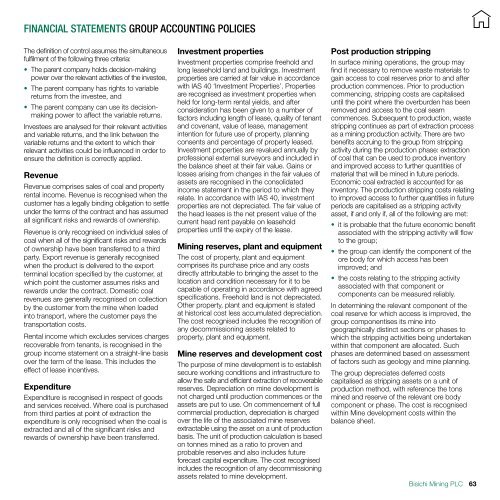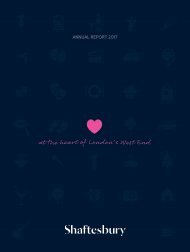BISICHI MINING PLC ANNUAL REPORT 2017
Create successful ePaper yourself
Turn your PDF publications into a flip-book with our unique Google optimized e-Paper software.
Financial statements Group accounting policies<br />
The definition of control assumes the simultaneous<br />
fulfilment of the following three criteria:<br />
• The parent company holds decision-making<br />
power over the relevant activities of the investee,<br />
• The parent company has rights to variable<br />
returns from the investee, and<br />
• The parent company can use its decisionmaking<br />
power to affect the variable returns.<br />
Investees are analysed for their relevant activities<br />
and variable returns, and the link between the<br />
variable returns and the extent to which their<br />
relevant activities could be influenced in order to<br />
ensure the definition is correctly applied.<br />
Revenue<br />
Revenue comprises sales of coal and property<br />
rental income. Revenue is recognised when the<br />
customer has a legally binding obligation to settle<br />
under the terms of the contract and has assumed<br />
all significant risks and rewards of ownership.<br />
Revenue is only recognised on individual sales of<br />
coal when all of the significant risks and rewards<br />
of ownership have been transferred to a third<br />
party. Export revenue is generally recognised<br />
when the product is delivered to the export<br />
terminal location specified by the customer, at<br />
which point the customer assumes risks and<br />
rewards under the contract. Domestic coal<br />
revenues are generally recognised on collection<br />
by the customer from the mine when loaded<br />
into transport, where the customer pays the<br />
transportation costs.<br />
Rental income which excludes services charges<br />
recoverable from tenants, is recognised in the<br />
group income statement on a straight-line basis<br />
over the term of the lease. This includes the<br />
effect of lease incentives.<br />
Expenditure<br />
Expenditure is recognised in respect of goods<br />
and services received. Where coal is purchased<br />
from third parties at point of extraction the<br />
expenditure is only recognised when the coal is<br />
extracted and all of the significant risks and<br />
rewards of ownership have been transferred.<br />
Investment properties<br />
Investment properties comprise freehold and<br />
long leasehold land and buildings. Investment<br />
properties are carried at fair value in accordance<br />
with IAS 40 ‘Investment Properties’. Properties<br />
are recognised as investment properties when<br />
held for long-term rental yields, and after<br />
consideration has been given to a number of<br />
factors including length of lease, quality of tenant<br />
and covenant, value of lease, management<br />
intention for future use of property, planning<br />
consents and percentage of property leased.<br />
Investment properties are revalued annually by<br />
professional external surveyors and included in<br />
the balance sheet at their fair value. Gains or<br />
losses arising from changes in the fair values of<br />
assets are recognised in the consolidated<br />
income statement in the period to which they<br />
relate. In accordance with IAS 40, investment<br />
properties are not depreciated. The fair value of<br />
the head leases is the net present value of the<br />
current head rent payable on leasehold<br />
properties until the expiry of the lease.<br />
Mining reserves, plant and equipment<br />
The cost of property, plant and equipment<br />
comprises its purchase price and any costs<br />
directly attributable to bringing the asset to the<br />
location and condition necessary for it to be<br />
capable of operating in accordance with agreed<br />
specifications. Freehold land is not depreciated.<br />
Other property, plant and equipment is stated<br />
at historical cost less accumulated depreciation.<br />
The cost recognised includes the recognition of<br />
any decommissioning assets related to<br />
property, plant and equipment.<br />
Mine reserves and development cost<br />
The purpose of mine development is to establish<br />
secure working conditions and infrastructure to<br />
allow the safe and efficient extraction of recoverable<br />
reserves. Depreciation on mine development is<br />
not charged until production commences or the<br />
assets are put to use. On commencement of full<br />
commercial production, depreciation is charged<br />
over the life of the associated mine reserves<br />
extractable using the asset on a unit of production<br />
basis. The unit of production calculation is based<br />
on tonnes mined as a ratio to proven and<br />
probable reserves and also includes future<br />
forecast capital expenditure. The cost recognised<br />
includes the recognition of any decommissioning<br />
assets related to mine development.<br />
Post production stripping<br />
In surface mining operations, the group may<br />
find it necessary to remove waste materials to<br />
gain access to coal reserves prior to and after<br />
production commences. Prior to production<br />
commencing, stripping costs are capitalised<br />
until the point where the overburden has been<br />
removed and access to the coal seam<br />
commences. Subsequent to production, waste<br />
stripping continues as part of extraction process<br />
as a mining production activity. There are two<br />
benefits accruing to the group from stripping<br />
activity during the production phase: extraction<br />
of coal that can be used to produce inventory<br />
and improved access to further quantities of<br />
material that will be mined in future periods.<br />
Economic coal extracted is accounted for as<br />
inventory. The production stripping costs relating<br />
to improved access to further quantities in future<br />
periods are capitalised as a stripping activity<br />
asset, if and only if, all of the following are met:<br />
• it is probable that the future economic benefit<br />
associated with the stripping activity will flow<br />
to the group;<br />
• the group can identify the component of the<br />
ore body for which access has been<br />
improved; and<br />
• the costs relating to the stripping activity<br />
associated with that component or<br />
components can be measured reliably.<br />
In determining the relevant component of the<br />
coal reserve for which access is improved, the<br />
group componentises its mine into<br />
geographically distinct sections or phases to<br />
which the stripping activities being undertaken<br />
within that component are allocated. Such<br />
phases are determined based on assessment<br />
of factors such as geology and mine planning.<br />
The group depreciates deferred costs<br />
capitalised as stripping assets on a unit of<br />
production method, with reference the tons<br />
mined and reserve of the relevant ore body<br />
component or phase. The cost is recognised<br />
within Mine development costs within the<br />
balance sheet.<br />
Bisichi Mining <strong>PLC</strong><br />
63



